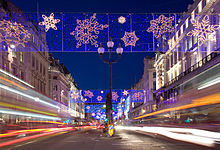Christmas decoration


Christmas decorations or Christmas decorations is the visual design inside and outside of closed rooms with (pre-) Christmas-typical objects.
Period

Shops and department stores usually start promoting Christmas and selling items as early as the end of September and early October. Traditionally, however, most Christmas decorations are set up “only” during Advent , Advent calendars on December 1st.
There are different dates for the so-called “decoration”. While the Christmas tree was traditionally decorated and removed in the Protestant area at the latest for Epiphany on January 6th, in Catholic families it often remains until Candlemas ( representation of the Lord ) on February 2nd . In rural areas, Mary's Candlemas used to be the end of Christmas time. Since the liturgical reform in the middle of the 20th century, the Christmas season ends with the feast of the baptism of the Lord , which is celebrated on the first Sunday after the Epiphany on January 6th.
Inside closed spaces
In the past, Christmas decorations were largely limited to the decoration inside closed rooms: For example, Christmas pyramids , candle arches , Advent calendars or Advent wreaths were already set up during Advent . This tradition lives on to this day. On Christmas Eve itself was and is still the festively decorated with glass balls, candles and tinsel decorated Christmas tree , the central Christmas decoration ( Christmas tree ornaments ), in many households also a so-called Christmas crib .
Outside closed spaces
In recent years, the amount of Christmas decorations outside of enclosed spaces has increased significantly.
On the one hand, there are now many inner cities and other shopping areas with Christmas decorations in the form of illuminated Christmas trees or light objects that often represent Christmas motifs (so-called Christmas lights ). One of the oldest light shows is the “ Essen Light Weeks ”, which have been presenting light motifs in the run-up to Christmas since December 1950.
On the other hand, many private individuals use decorative objects that are attached to windows - such as electrically flashing stars - or outside the house, for example Santa Clauses climbing up the house or fairy lights on a tree in the front yard.
Christmas house
Following the US model, there are also so-called “Christmas houses” in Europe, in which, on and around them, decorations of all kinds are attached. The “Christmas House ” in Calle is probably the most light-intensive object of its kind in Germany with 420,000 electric lights.
The first Christmas decorations are already set up in the second half of November, and they are often not dismantled until the beginning of January.
Environmental aspects
Christmas lighting has negative consequences for the environment that should not be underestimated due to the energy consumption, which is often rated as inappropriately high. A single string of lights in a private household consumes an average of around 30 kilowatt hours of electrical energy during the Christmas season . In 2006, over 400 million kilowatt hours of energy were used for Christmas lighting in German households. This would be enough to continuously supply 140,000 households with energy for a year. In the municipalities, on the other hand, only around 10 million kilowatt hours of energy were used for Christmas lighting. A total of around 600 billion kWh of electricity in Germany annually consumes .
What can be observed, however, is a gradual replacement of traditional incandescent lamps with light-emitting diodes with significantly lower power consumption, not only at Christmas markets , but also during the “Essen Light Weeks” and in private households.
In addition to energy consumption, light pollution itself also has a negative impact on the environment. That is why there has been no Christmas lighting in the trees in Villingen-Schwenningen since 2018 .
Web links
- Christmas decorations and design ideas for Christmas
- Interesting facts about various Christmas decorations
Individual evidence
- ↑ http://www.ipp.mpg.de/ippcms/ep/lösungen/ep200604/0406_light.html
- ↑ In December 2011, the Frankfurter Rundschau named the value of 500 million kilowatt hours, corresponding to the annual electricity consumption of 140,000 households. Advent, Advent, more than eight billion lights are burning . In: Frankfurter Rundschau , December 12, 2011. Accessed December 12, 2011.
- ↑ Essen Light Weeks 2008/09 - data, figures and facts
- ↑ Fabian Riesterer: Environmental protection instead of tree lighting. In: schwarzwaelder-bote.de . November 24, 2018. Retrieved November 27, 2018 .


